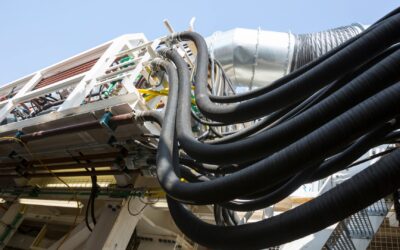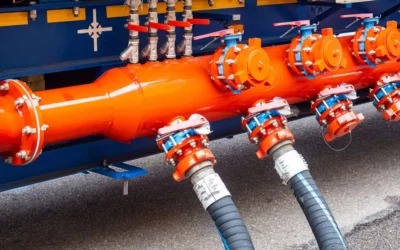Overview of HDPE Pipes
High-density polyethylene (HDPE) pipes have emerged as a cornerstone in modern infrastructure projects due to their unique properties and adaptability. Unlike traditional materials such as concrete, metal, or PVC, HDPE pipes combine strength, durability, and flexibility, making them ideal for a wide range of applications. These pipes, available in various HDPE pipe dimensions, are commonly used in sectors like water distribution, gas supply, sewage systems, mining, and industrial processes. The lightweight nature and ease of installation of HDPE pipes, coupled with standardized HDPE pipe dimensions, make them a cost-effective choice. Additionally, the versatility offered by HDPE pipe dimensions ensures suitability for both large-scale municipal projects and smaller rural installations.
HDPE pipes are known for their high strength-to-density ratio, which allows them to withstand significant pressure while maintaining a relatively lightweight profile. With a range of HDPE pipe dimensions available, these pipes can be tailored to meet the specific requirements of various applications, ensuring optimal performance. This makes them particularly valuable in scenarios requiring long-term reliability under harsh conditions, such as underground installations or environments exposed to chemicals or extreme temperatures. Additionally, the ability to manufacture HDPE pipes in continuous lengths, regardless of HDPE pipe dimensions, reduces the number of joints and minimizes potential points of failure. This feature is especially beneficial in critical applications like gas and potable water distribution, where leaks can have serious consequences.
Benefits of HDPE Pipes

The growing popularity of HDPE pipes can be attributed to their many advantages, which make them a superior alternative to traditional materials. Key benefits include:
- Durability:
HDPE pipes exhibit exceptional resistance to corrosion, chemicals, and UV light, which are common causes of pipe degradation. With a variety of HDPE pipe dimensions available, they can be customized to suit specific environmental conditions and project needs. Unlike metal pipes, HDPE pipes do not rust or corrode, even in highly acidic or alkaline environments. This durability, combined with the adaptability provided by standardized HDPE pipe dimensions, ensures a long service life, often exceeding 50 years, with minimal maintenance. - Flexibility:
HDPE pipes are inherently flexible, allowing them to bend without cracking or breaking. This property, combined with the availability of various HDPE pipe dimensions, makes them particularly advantageous for installations in challenging terrains, such as rocky areas or regions prone to seismic activity. Their flexibility also facilitates trenchless installation methods like horizontal directional drilling (HDD), which minimizes surface disruption and reduces installation costs. - Environmental Friendliness:
HDPE is a recyclable material, aligning with the growing emphasis on sustainability in construction and infrastructure. The production of HDPE pipes requires less energy compared to other materials, and their lightweight nature reduces transportation emissions. Additionally, their long lifespan reduces the need for replacements, further minimizing environmental impact. - Leak-Free Joints:
HDPE pipes are typically joined using fusion techniques, such as butt fusion or electrofusion, which create seamless, leak-free connections. This feature significantly enhances the reliability and efficiency of systems using HDPE pipes, especially in applications where leaks can lead to water loss, environmental contamination, or safety hazards. - Cost-Effectiveness:
Although the initial cost of HDPE pipes may be higher than some alternatives, their durability, low maintenance requirements, and ease of installation result in substantial long-term savings. Additionally, their resistance to scaling and sediment buildup reduces operational costs in fluid transport systems.
Purpose of the Guide
Selecting the correct HDPE pipe dimensions is a crucial step in ensuring the success and longevity of any project. The HDPE pipe dimensions directly influence their pressure-handling capacity, flow rate, and overall performance. However, the wide variety of available HDPE pipe sizes and specifications can be overwhelming for those unfamiliar with HDPE piping systems.
This guide aims to provide a comprehensive understanding of HDPE pipe dimensions and their implications for various applications. Whether you’re a contractor, engineer, project manager, or simply exploring piping solutions, this resource will equip you with the knowledge to make informed decisions. By understanding the relationship between HDPE pipe dimensions and factors like pressure rating, temperature tolerance, and material requirements, you can optimize your piping systems for maximum efficiency and reliability.
From explaining the basics of HDPE pipe measurements to detailing practical applications across industries, this guide covers everything you need to know. Whether your project involves water distribution, gas supply, industrial fluid transport, or marine installations, this guide will help you choose the right HDPE pipe size for your needs.
Understanding HDPE Pipe Dimension.

What Are HDPE Pipe Dimensions?
Three main characteristics define HDPE pipe dimensions:
- Diameter: The external (Outer Diameter or OD) and internal (Inner Diameter or ID) measurements determine the pipe’s capacity.
- Wall Thickness: A thicker wall increases pressure resistance and structural integrity.
- SDR (Standard Dimension Ratio): The ratio of pipe diameter to wall thickness. Lower SDR values indicate thicker walls and higher pressure resistance.
The relationship between pipe size and pressure rating is crucial. Larger HDPE pipe diameters with thinner walls (higher SDR) handle lower pressures, while smaller HDPE pipe diameters with thicker walls (lower SDR) withstand higher pressures.
Common Measurement Standards
HDPE pipes adhere to global standards, ensuring consistency and reliability. Common standards include:
- ASTM International: Widely used in the Americas for HDPE pipe dimensions and material specifications.
- ISO Standards: Provide internationally recognized guidelines for HDPE pipes.
- DIN/EN Standards: Used primarily in Europe.
Key Terms to Know
- Outer Diameter (OD): The external width of the pipe.
- Inner Diameter (ID): The internal width, which affects flow capacity.
- Nominal Size: A standardized identifier for HDPE pipe dimensions, often related to OD.
HDPE Pipe Sizing: Factors to Consider

Application Requirements
Different industries demand varying HDPE pipe sizes. For example:
- Water Systems: Require moderate to large HDPE pipe diameters for efficient flow.
- Gas Distribution: Emphasizes safety, with HDPE pipe sizes optimized for specific pressures.
- Mining and Industrial Use: Prefers larger hdpe pipe diameters for transporting slurry and chemicals.
Pressure Ratings and SDRs
Pressure ratings, determined by SDR, are vital in selecting the right pipe. For instance:
- SDR 11 pipes are ideal for high-pressure systems.
- SDR 26 pipes are better for low-pressure applications.
Temperature Variations and Material Considerations
Temperature fluctuations can cause HDPE pipes to expand or contract. Selecting the right pipe size ensures stability and performance under varying environmental conditions.
HDPE Pipe Dimensions Charts

Standard HDPE Pipe Sizes
HDPE pipes are available in a wide range of HDPE pipe sizes, from small HDPE pipe diameters (20mm) to large ones (1200mm+). Below is an example of standard HDPE pipe sizes and their corresponding SDRs:
| Nominal Diameter (mm) | SDR 11 (PN16) | SDR 17 (PN10) | SDR 26 (PN6) |
| 90 | 8.2 mm | 5.4 mm | 3.4 mm |
| 200 | 18.2 mm | 11.8 mm | 7.7 mm |
| 450 | 40.9 mm | 26.5 mm | 17.3 mm |
Custom Sizing Options
Manufacturers can produce custom HDPE pipe sizes for specialized applications, offering flexibility for unique projects.
Applications of HDPE Pipe Dimensions

Water Distribution Systems
HDPE pipes are widely used in municipal water supply systems due to their leak-free joints and resistance to contaminants. Typical HDPE pipe diameters range from 50mm to 315mm for potable water systems.
Gas Distribution
Gas distribution systems often use smaller-diameter pipes with thick walls (low SDR) for safety and pressure containment. Common HDPE pipe sizes include 20mm to 125mm.
Industrial and Mining Uses
For transporting slurry, chemicals, and industrial fluids, large-diameter pipes (up to 1600mm) are preferred. These pipes withstand abrasive materials and high flow rates.
Marine and Dredging Applications
In dredging projects, HDPE pipes provide excellent buoyancy and resistance to saltwater. HDPE pipe sizes range from medium to large HDPE Pipe diameters, depending on the dredging volume.
Installation Tips Based on HDPE Pipe Dimensions
Handling and Transportation
Proper handling ensures the integrity of the pipes. For larger HDPE Pipe diameters, specialized equipment is often required. Pipes should be transported in ways that prevent deformation or damage.
Jointing Techniques
HDPE pipes can be joined using:
- Butt Fusion: Suitable for pipes of all HDPE pipe sizes, creating a seamless joint.
- Electrofusion: Ideal for smaller HDPE pipe diameters or difficult-to-reach areas.
- Mechanical Fittings: Used for temporary connections or when welding isn’t feasible.
Site Preparation and Support
Larger pipes require adequate trench preparation to ensure stability. Support systems must align with the pipe size and expected load.
Choosing the Right HDPE Pipe Size
Selecting the correct HDPE pipe size is a critical step in ensuring the efficiency, safety, and longevity of your piping system. The right size directly affects the system’s performance, including its capacity to handle flow rates, operational pressure, and the specific medium being transported. Making an informed choice involves a thorough evaluation of your project’s requirements and constraints. Here are the key considerations and steps for choosing the ideal HDPE pipe size:
Assessing Your Needs
Properly assessing your system’s requirements is fundamental to selecting the correct pipe size. Several factors need to be evaluated:
- Flow Rate Requirements:
Determine the volume of fluid or gas the system must transport within a given timeframe. The inner diameter (ID) of the pipe plays a pivotal role in achieving the desired flow rate. Undersized pipes may lead to restricted flow and increased energy consumption, while oversized pipes may incur unnecessary material costs. - Operational Pressure:
Identify the maximum pressure the system will experience. HDPE pipe dimensions come in various Standard Dimension Ratios (SDRs), which dictate their pressure-handling capabilities. Lower SDR values correspond to thicker walls and higher pressure resistance. Matching the pipe’s pressure rating to the system’s requirements is essential to avoid failures. - Medium Being Transported:
The properties of the transported medium (e.g., water, gas, chemicals, or slurry) impact the pipe size and material choice. For instance, corrosive or abrasive substances may require larger hdpe pipe diameters or thicker walls to ensure durability and reduce wear over time. - Environmental Conditions:
Consider factors like temperature variations, soil conditions, and exposure to UV light. These conditions may influence the material’s thermal expansion and mechanical properties, affecting the sizing and installation requirements.
Understanding Pipe Specifications
HDPE pipes are available in a range of sizes and pressure ratings. Familiarize yourself with key specifications:
- Nominal Diameter (ND): Refers to the standardized sizing convention for pipes.
- Outer Diameter (OD) and Inner Diameter (ID) Directly affect the pipe’s capacity and fit with fittings or connections.
- Wall Thickness: Impacts the pressure rating and structural strength of the pipe.
Application-Specific Requirements
Different industries and applications have unique sizing needs. For example:
- In water distribution, larger diameters are typically used for main supply lines, while smaller sizes are used for branch lines.
- In gas distribution, safety concerns prioritize thick-walled pipes with precise diameters to handle pressure and prevent leaks.
- For industrial or mining applications, where slurry or abrasive materials are transported, oversized pipes with high durability are often selected.
Considering Future Scalability
When planning a piping system, anticipate future demand increases. Opting for slightly larger diameters can accommodate higher flow rates, avoiding the need for costly upgrades or replacements later. This is especially important in municipal or industrial systems expected to expand.
Consulting with Experts
Navigating the complexities of HDPE pipe sizing is significantly easier with expert guidance. Collaborating with manufacturers, engineers, and industry professionals ensures that all critical factors are considered. They can provide insights into:
- The most suitable SDR for your pressure requirements.
- How to balance cost efficiency with performance.
- Custom sizing options for unique or non-standard applications.
Manufacturers can also supply detailed product specifications, charts, and software tools to assist in making precise calculations. Additionally, consulting with installation professionals can help you account for practical considerations like jointing methods, trench preparation, and environmental impacts.
Using HDPE pipe dimensions Charts and Calculation Tools
HDPE pipe dimensions charts and hydraulic calculators can help match pipe sizes to specific project parameters. These tools allow for precise estimations of flow rates, pressure drops, and other key metrics, helping ensure that the selected HDPE pipe dimensions align perfectly with operational requirements.
Finalizing the Decision
Once all factors have been analyzed, review the project scope and confirm that the selected pipe size meets both current and future needs. Ensure that the HDPE pipe dimensions comply with relevant standards (e.g., ASTM, ISO, or EN) and verify compatibility with fittings, joints, and other system components.
Choosing the right HDPE pipe size is a meticulous process that requires balancing technical specifications, operational demands, and budget constraints. By thoroughly assessing your needs, leveraging expert advice, and using precise tools, you can make informed decisions that optimize system performance and long-term reliability.
Conclusion
HDPE pipes are a cornerstone of modern infrastructure due to their unmatched versatility, durability, and environmental benefits. Their resistance to corrosion, chemicals, and extreme conditions, combined with their flexibility and recyclability, makes them an excellent choice across a wide range of applications, including municipal water supply, gas distribution, industrial transport, and marine dredging. Selecting the appropriate HDPE pipe dimensions—factoring in diameter, wall thickness, and SDR—is critical to ensuring optimal performance, efficiency, and longevity for your project.




